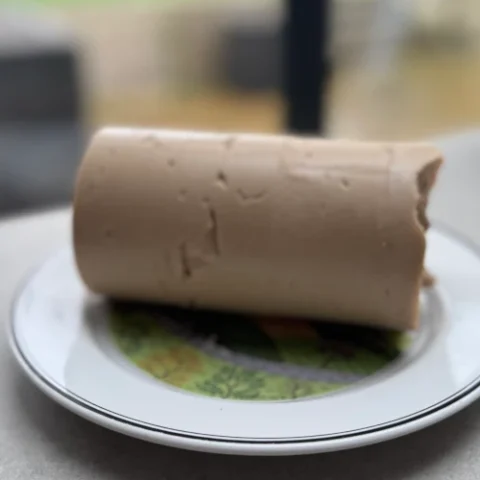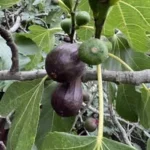
Vegan Foie Gras
There is no need to force-feed your cashew nuts with Armagnac to obtain a cruelty-free vegan foie gras surprisingly close to the real one in terms of look, texture and taste.
Ingredients
- 2 cups raw cashews
- 1/4 cup deodorised cocoa butter
- 1/4 cup deodorised coconut oil
- 2 tbsp water
- 3 tbsp sweet white miso
- 2 tbsp & 1/2 tsp Armagnac (or Cognac)
- 2 tbsp nutritional yeast
- 2 tbsp tahini
- 1 tsp truffle oil
- 1/2 tsp shiitake powder
- 1/4 tsp sea salt
- 1/8 tsp black or white pepper
Yellow fat (optional)
- 3 tbsp refined coconut oil
- 1/8 tsp turmeric
Instructions
- Soak the cashews overnight. Drain and rinse the cashews.
- To make the shiitake powder: Grind 3 dried shiitake mushrooms in a small grinder or food processor until you get a very fine powder. Set aside 1/2 tsp powder and keep the leftover in an airtight container for other uses.
- Add the cashews to the bowl of a blender with the water, white miso, Armagnac, nutritional yeast, tahini, shiitake powder, and truffle oil.
- Melt the cocoa butter in a small saucepan and measure 1/4 cup of melted cocoa butter and add them to the blender. Do the same for the coconut oil.
- Add the salt and pepper and blend until completely smooth, scraping down the sides from time to time. The mixture will be very thick, if you don't have a powerful blender, use a food processor.
- Stack three 7cm (4cm tall) cake rind moulds and line them with parchment paper (sides and bottom). Pour the mixture into the moulds and flatten the top. Alternatively, you can use any pan you have on hand: round, rectangular, etc. Smooth the top using a knife and cover it with plastic film.
- Place in the refrigerator for at least one day, it will become much firmer and the flavours will have time to merge.
- For the yellow fat (optional): Melt the refined coconut oil and turmeric over low heat and mix well. Let sit at room temperature until the coconut oil becomes spreadable again. Using your fingers, spread some coloured coconut oil around the foie gras to make it look like yellow fat.
- Serve cold and spread on toasted bread, vegan brioche, etc. This vegan foie gras pairs well with sweet French white wines.
Nutrition Information:
Yield: 24 Serving Size: 1Amount Per Serving: Calories: 131Total Fat: 12gSaturated Fat: 6gTrans Fat: 0gUnsaturated Fat: 5gCholesterol: 0mgSodium: 106mgCarbohydrates: 4gFiber: 1gSugar: 1gProtein: 3g
The history of foie gras: from ancient Egypt to modern tables
Few dishes symbolise culinary indulgence quite like foie gras. Meaning “fat liver” in French, it refers to the enlarged liver of a specially fattened duck or goose. Traditionally served as a silky terrine, a rolled torchon, or seared into buttery slices, foie gras has long stood as a hallmark of French haute cuisine. But its story spans millennia and continents, blending ancient agricultural practices, Roman decadence, and French refinement into one remarkable culinary evolution.
Ancient origins: Egypt, Rome, and the birth of “fat liver”
The roots of foie gras stretch deep into antiquity. Archaeologists have uncovered tomb paintings in ancient Egypt depicting workers hand-feeding geese to fatten them — a clear sign that the Egyptians were early pioneers of this indulgent art. Their discovery was simple yet revolutionary: migratory birds, preparing for long flights, naturally stored fat in their livers when they were overfed. Humans merely encouraged the process.
From Egypt, the practice spread across the Mediterranean to Greece and Rome. The Romans took a liking to goose liver to new heights. They fed their geese figs, resulting in a sweet, rich liver they called iecur ficatum. This term is more than a historical curiosity—it’s the linguistic ancestor of several modern words for “liver”: French foie, Italian fegato, and Spanish hígado. You can explore Roman and Egyptian artefacts showing early food culture at the Metropolitan Museum of Art.
From central Europe to France: a culinary renaissance
Modern foie gras owes much to the traditions of Central and Eastern Europe. In medieval times, Jewish communities in Alsace and Hungary perfected the art of goose-fattening. Because kosher law forbids the use of butter, they relied heavily on goose fat (schmaltz) and became experts in raising plump birds.
As these communities migrated westward, their culinary expertise spread. France — especially Alsace, Périgord, and Gers — embraced the technique and elevated it into an art form. By the 17th and 18th centuries, foie gras was a delicacy of the French aristocracy. In 1780, Marshal Jean-Joseph de Saint-Ignon famously praised pâté de foie gras de Strasbourg as one of the world’s most extraordinary dishes.
The French connection remains so strong that foie gras is now officially recognised as part of France’s protected culinary heritage. You can read more on the French Ministry of Agriculture’s official gastronomy page.
Even today, foie gras remains a staple of festive meals, such as Christmas and New Year’s — a luxurious reminder of France’s rich gastronomic heritage.
The ethics debate: tradition meets modern values
Despite its prestige, foie gras has long attracted ethical debate. The traditional process of gavage (force-feeding) involves inserting a feeding tube into the bird’s throat to fatten the liver rapidly. Many animal-welfare advocates argue this causes distress and injury. As a result, countries including the UK, Denmark, and Australia have banned its production, though importation is still permitted.
French producers defend foie gras as an artisanal product steeped in heritage, regulated by strict standards. To learn more about European legislation on animal welfare, visit the European Commission on Animal Welfare.
However, modern diners increasingly seek ethical alternatives that blend indulgence with compassion. This shift has given rise to vegan foie gras, also known as faux gras.
The rise of vegan “foie gras”
Vegan and vegetarian chefs have developed astonishingly creative substitutes for foie gras. Instead of animal products, they use a blend of mushrooms, lentils, nuts, and aromatic herbs to replicate the earthy depth of liver pâté. A touch of brandy, truffle oil, or cognac adds that unmistakable gourmet note. The result? A smooth, decadent spread that captures the essence of French gastronomy—minus the cruelty.
Not only are these plant-based versions ethical, but they’re also sustainable and nutrient-rich. Ingredients like cashews and lentils provide healthy fats, iron, and protein. Mushrooms contribute umami depth while keeping the texture beautifully creamy.
For those who still wish to experience traditional foie gras, learning its history adds appreciation and perspective. And for the ethically minded, modern culinary science ensures that indulgence and integrity no longer need to be at odds.



